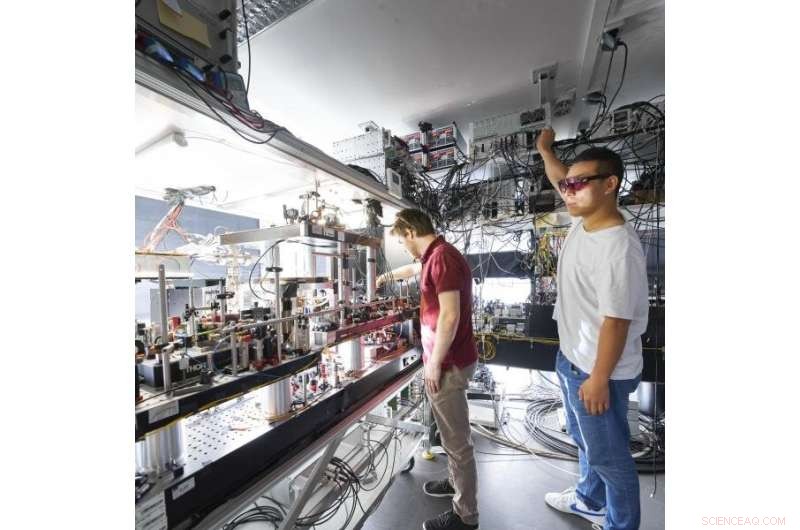
Schéma du montage expérimental. Dans chaque nœud, situé dans des bâtiments distants de 400 m, un seul 87 L'atome Rb est chargé dans un piège dipolaire optique. Les deux atomes sont excités de manière synchrone à l'état 5 2 P3/2 |F′=0, mF′ =0⟩ pour générer un enchevêtrement atome-photon dans la désintégration spontanée ultérieure. Les photons uniques émis à une longueur d'onde de 780 nm sont collectés à l'aide d'objectifs à grande ouverture numérique et couplés dans des fibres monomodes menant aux dispositifs QFC. Là, ils sont convertis en longueur d'onde télécom (λ = 1 517 nm) par génération de fréquence de différence dans un guide d'onde en niobate de lithium périodiquement polarisé (PPLN) situé dans une configuration de type interféromètre de Sagnac, une telle configuration maintient entièrement l'état quantique de polarisation du photon. Les photons convertis sont guidés vers une station intermédiaire par des liaisons de fibres d'une longueur allant jusqu'à 16,5 km, où l'intrication est transférée aux atomes par un BSM. Après avoir réussi à générer un enchevêtrement atome-atome, les atomes sont analysés indépendamment par une impulsion de lecture dont la polarisation, définie par une lame demi-onde (HWP) et une lame quart d'onde (QWP), définit le paramètre de mesure. PC, contrôleurs de polarisation. Crédit :Nature (2022). DOI :10.1038/s41586-022-04764-4
Un réseau dans lequel la transmission des données est parfaitement sécurisée contre le piratage ? Si les physiciens réussissent, cela deviendra réalité un jour grâce au phénomène de mécanique quantique connu sous le nom d'intrication. Pour les particules intriquées, la règle est la suivante :Si vous mesurez l'état de l'une des particules, alors vous connaissez automatiquement l'état de l'autre. Peu importe la distance qui sépare les particules intriquées. Il s'agit d'une situation idéale pour transmettre des informations sur de longues distances d'une manière qui rend l'écoute indiscrète impossible.
Une équipe dirigée par les physiciens, le professeur Harald Weinfurter du LMU et le professeur Christoph Becher de l'Université de la Sarre, vient de coupler deux mémoires quantiques atomiques sur une connexion à fibre optique de 33 kilomètres de long. This is the longest distance so far that anyone has ever managed entanglement via a telecom fiber.
The quantum mechanical entanglement is mediated via photons emitted by the two quantum memories. A decisive step was the researchers' shifting of the wavelength of the emitted light particles to a value that is used for conventional telecommunications. "By doing this, we were able to significantly reduce the loss of photons and create entangled quantum memories even over long distances of fiber optic cable," says Weinfurter.
Generally speaking, quantum networks consist of nodes of individual quantum memories—such as atoms, ions, or defects in crystal lattices. These nodes are able to receive, store, and transmit quantum states. Mediation between the nodes can be accomplished using light particles that are exchanged either over the air or in a targeted manner via fiber optic connection. For their experiment, the researchers use a system comprised of two optically trapped rubidium atoms in two laboratories on the LMU campus. The two locations are connected via a 700-meter-long fiber optic cable, which runs underneath Geschwister Scholl Square in front of the main building of the university. By adding extra fibers on coils, connections of up to 33 kilometers in length can be achieved.
A laser pulse excites the atoms, after which they spontaneously fall back into their ground state, each thereby emitting a photon. En raison de la conservation du moment cinétique, le spin de l'atome est intriqué avec la polarisation de son photon émis. These light particles can then be used to create a quantum mechanical coupling of the two atoms. To do this, the scientists sent them through the fiber optic cable to a receiver station, where a joint measurement of the photons indicates an entanglement of the quantum memories.

Credit:Jan Greune
However, most quantum memories emit light with wavelengths in the visible or near-infrared range. "In fiber optics, these photons make it just a few kilometers before they are lost," explains Christoph Becher. For this reason, the physicist from Saarbrücken and his team optimized the wavelength of the photons for their journey in the cable. Using two quantum frequency converters, they increased the original wavelength from 780 nanometers to a wavelength of 1,517 nanometers.
"This is close to the so-called telecom wavelength of around 1,550 nanometers," says Becher. The telecom band is the frequency range in which the transmission of light in fiber optics has the lowest losses. Becher's team accomplished the conversion with an unprecedented efficiency of 57%. At the same time, they managed to preserve the quality of the information stored in the photons to a high degree, which is a condition of quantum coupling.
"The significance of our experiment is that we actually entangle two stationary particles—that is to say, atoms that function as quantum memories," says Tim van Leent, lead author of the paper published in Nature . "This is much more difficult than entangling photons, but it opens up many more application possibilities."
The researchers think that the system they developed could be used to construct large-scale quantum networks and for the implementation of secure quantum communication protocols. "The experiment is an important step on the path to the quantum internet based on existing fiber optic infrastructure," says Harald Weinfurter. On the way to quantum networks